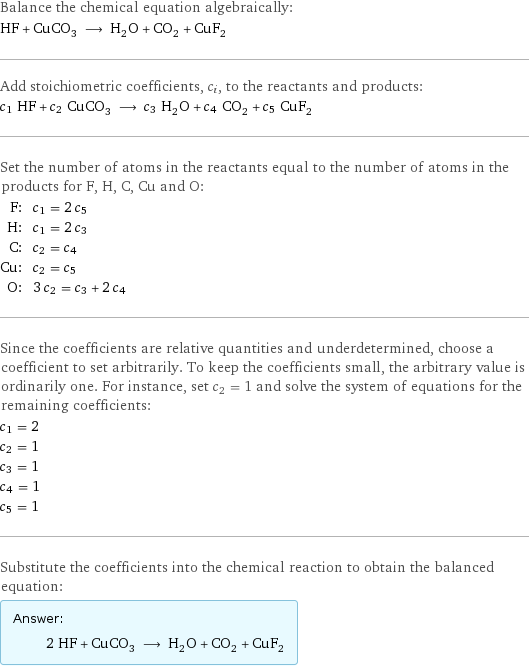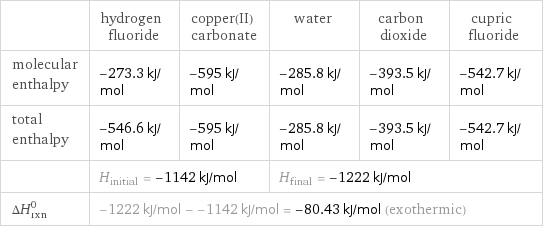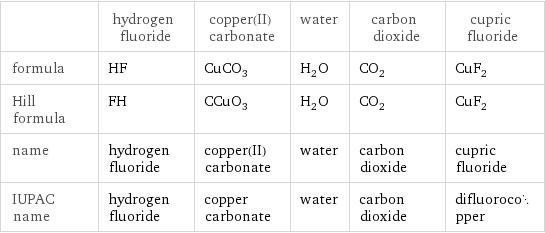Input interpretation

HF hydrogen fluoride + CuCO_3 copper(II) carbonate ⟶ H_2O water + CO_2 carbon dioxide + CuF_2 cupric fluoride
Balanced equation

Balance the chemical equation algebraically: HF + CuCO_3 ⟶ H_2O + CO_2 + CuF_2 Add stoichiometric coefficients, c_i, to the reactants and products: c_1 HF + c_2 CuCO_3 ⟶ c_3 H_2O + c_4 CO_2 + c_5 CuF_2 Set the number of atoms in the reactants equal to the number of atoms in the products for F, H, C, Cu and O: F: | c_1 = 2 c_5 H: | c_1 = 2 c_3 C: | c_2 = c_4 Cu: | c_2 = c_5 O: | 3 c_2 = c_3 + 2 c_4 Since the coefficients are relative quantities and underdetermined, choose a coefficient to set arbitrarily. To keep the coefficients small, the arbitrary value is ordinarily one. For instance, set c_2 = 1 and solve the system of equations for the remaining coefficients: c_1 = 2 c_2 = 1 c_3 = 1 c_4 = 1 c_5 = 1 Substitute the coefficients into the chemical reaction to obtain the balanced equation: Answer: | | 2 HF + CuCO_3 ⟶ H_2O + CO_2 + CuF_2
Structures

+ ⟶ + +
Names

hydrogen fluoride + copper(II) carbonate ⟶ water + carbon dioxide + cupric fluoride
Reaction thermodynamics
Enthalpy

| hydrogen fluoride | copper(II) carbonate | water | carbon dioxide | cupric fluoride molecular enthalpy | -273.3 kJ/mol | -595 kJ/mol | -285.8 kJ/mol | -393.5 kJ/mol | -542.7 kJ/mol total enthalpy | -546.6 kJ/mol | -595 kJ/mol | -285.8 kJ/mol | -393.5 kJ/mol | -542.7 kJ/mol | H_initial = -1142 kJ/mol | | H_final = -1222 kJ/mol | | ΔH_rxn^0 | -1222 kJ/mol - -1142 kJ/mol = -80.43 kJ/mol (exothermic) | | | |
Equilibrium constant
![Construct the equilibrium constant, K, expression for: HF + CuCO_3 ⟶ H_2O + CO_2 + CuF_2 Plan: • Balance the chemical equation. • Determine the stoichiometric numbers. • Assemble the activity expression for each chemical species. • Use the activity expressions to build the equilibrium constant expression. Write the balanced chemical equation: 2 HF + CuCO_3 ⟶ H_2O + CO_2 + CuF_2 Assign stoichiometric numbers, ν_i, using the stoichiometric coefficients, c_i, from the balanced chemical equation in the following manner: ν_i = -c_i for reactants and ν_i = c_i for products: chemical species | c_i | ν_i HF | 2 | -2 CuCO_3 | 1 | -1 H_2O | 1 | 1 CO_2 | 1 | 1 CuF_2 | 1 | 1 Assemble the activity expressions accounting for the state of matter and ν_i: chemical species | c_i | ν_i | activity expression HF | 2 | -2 | ([HF])^(-2) CuCO_3 | 1 | -1 | ([CuCO3])^(-1) H_2O | 1 | 1 | [H2O] CO_2 | 1 | 1 | [CO2] CuF_2 | 1 | 1 | [CuF2] The equilibrium constant symbol in the concentration basis is: K_c Mulitply the activity expressions to arrive at the K_c expression: Answer: | | K_c = ([HF])^(-2) ([CuCO3])^(-1) [H2O] [CO2] [CuF2] = ([H2O] [CO2] [CuF2])/(([HF])^2 [CuCO3])](../image_source/4875a99d8b405de2245f8c81aec588d8.png)
Construct the equilibrium constant, K, expression for: HF + CuCO_3 ⟶ H_2O + CO_2 + CuF_2 Plan: • Balance the chemical equation. • Determine the stoichiometric numbers. • Assemble the activity expression for each chemical species. • Use the activity expressions to build the equilibrium constant expression. Write the balanced chemical equation: 2 HF + CuCO_3 ⟶ H_2O + CO_2 + CuF_2 Assign stoichiometric numbers, ν_i, using the stoichiometric coefficients, c_i, from the balanced chemical equation in the following manner: ν_i = -c_i for reactants and ν_i = c_i for products: chemical species | c_i | ν_i HF | 2 | -2 CuCO_3 | 1 | -1 H_2O | 1 | 1 CO_2 | 1 | 1 CuF_2 | 1 | 1 Assemble the activity expressions accounting for the state of matter and ν_i: chemical species | c_i | ν_i | activity expression HF | 2 | -2 | ([HF])^(-2) CuCO_3 | 1 | -1 | ([CuCO3])^(-1) H_2O | 1 | 1 | [H2O] CO_2 | 1 | 1 | [CO2] CuF_2 | 1 | 1 | [CuF2] The equilibrium constant symbol in the concentration basis is: K_c Mulitply the activity expressions to arrive at the K_c expression: Answer: | | K_c = ([HF])^(-2) ([CuCO3])^(-1) [H2O] [CO2] [CuF2] = ([H2O] [CO2] [CuF2])/(([HF])^2 [CuCO3])
Rate of reaction
![Construct the rate of reaction expression for: HF + CuCO_3 ⟶ H_2O + CO_2 + CuF_2 Plan: • Balance the chemical equation. • Determine the stoichiometric numbers. • Assemble the rate term for each chemical species. • Write the rate of reaction expression. Write the balanced chemical equation: 2 HF + CuCO_3 ⟶ H_2O + CO_2 + CuF_2 Assign stoichiometric numbers, ν_i, using the stoichiometric coefficients, c_i, from the balanced chemical equation in the following manner: ν_i = -c_i for reactants and ν_i = c_i for products: chemical species | c_i | ν_i HF | 2 | -2 CuCO_3 | 1 | -1 H_2O | 1 | 1 CO_2 | 1 | 1 CuF_2 | 1 | 1 The rate term for each chemical species, B_i, is 1/ν_i(Δ[B_i])/(Δt) where [B_i] is the amount concentration and t is time: chemical species | c_i | ν_i | rate term HF | 2 | -2 | -1/2 (Δ[HF])/(Δt) CuCO_3 | 1 | -1 | -(Δ[CuCO3])/(Δt) H_2O | 1 | 1 | (Δ[H2O])/(Δt) CO_2 | 1 | 1 | (Δ[CO2])/(Δt) CuF_2 | 1 | 1 | (Δ[CuF2])/(Δt) (for infinitesimal rate of change, replace Δ with d) Set the rate terms equal to each other to arrive at the rate expression: Answer: | | rate = -1/2 (Δ[HF])/(Δt) = -(Δ[CuCO3])/(Δt) = (Δ[H2O])/(Δt) = (Δ[CO2])/(Δt) = (Δ[CuF2])/(Δt) (assuming constant volume and no accumulation of intermediates or side products)](../image_source/71992b9f4fb8ba30f6caf5b2f188a0f7.png)
Construct the rate of reaction expression for: HF + CuCO_3 ⟶ H_2O + CO_2 + CuF_2 Plan: • Balance the chemical equation. • Determine the stoichiometric numbers. • Assemble the rate term for each chemical species. • Write the rate of reaction expression. Write the balanced chemical equation: 2 HF + CuCO_3 ⟶ H_2O + CO_2 + CuF_2 Assign stoichiometric numbers, ν_i, using the stoichiometric coefficients, c_i, from the balanced chemical equation in the following manner: ν_i = -c_i for reactants and ν_i = c_i for products: chemical species | c_i | ν_i HF | 2 | -2 CuCO_3 | 1 | -1 H_2O | 1 | 1 CO_2 | 1 | 1 CuF_2 | 1 | 1 The rate term for each chemical species, B_i, is 1/ν_i(Δ[B_i])/(Δt) where [B_i] is the amount concentration and t is time: chemical species | c_i | ν_i | rate term HF | 2 | -2 | -1/2 (Δ[HF])/(Δt) CuCO_3 | 1 | -1 | -(Δ[CuCO3])/(Δt) H_2O | 1 | 1 | (Δ[H2O])/(Δt) CO_2 | 1 | 1 | (Δ[CO2])/(Δt) CuF_2 | 1 | 1 | (Δ[CuF2])/(Δt) (for infinitesimal rate of change, replace Δ with d) Set the rate terms equal to each other to arrive at the rate expression: Answer: | | rate = -1/2 (Δ[HF])/(Δt) = -(Δ[CuCO3])/(Δt) = (Δ[H2O])/(Δt) = (Δ[CO2])/(Δt) = (Δ[CuF2])/(Δt) (assuming constant volume and no accumulation of intermediates or side products)
Chemical names and formulas

| hydrogen fluoride | copper(II) carbonate | water | carbon dioxide | cupric fluoride formula | HF | CuCO_3 | H_2O | CO_2 | CuF_2 Hill formula | FH | CCuO_3 | H_2O | CO_2 | CuF_2 name | hydrogen fluoride | copper(II) carbonate | water | carbon dioxide | cupric fluoride IUPAC name | hydrogen fluoride | copper carbonate | water | carbon dioxide | difluorocopper